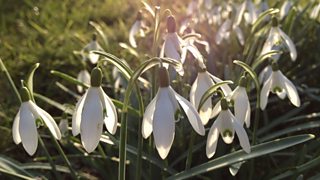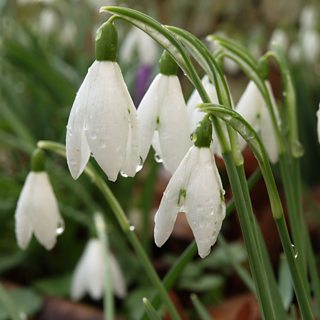By Archie Thomas, Sarah Shuttleworth & Dr Elizabeth Cooke
Nothing quite delights like the first sight of snowdrops in January. Their plucky appearance – seemingly against the odds - has long heralded a beginning of the end of deep Winter and engendered feelings of hope and promise for the new year. Whether fluttering on a grassy road verge or carpeting the damp woodland floor, their brilliant white blooms put a spring in the step of even the weariest walker.

Snowdrops by Trevor Dines, Plantlife
More extreme weather events triggered by climate change are impacting on flowering times and the unseasonably mild 2021 festive period saw reports flood in of snowdrops erupting earlier than in previous years. It’s still too early to gather full data but here at Plantlife we strive to keep track of such changes in wild plant communities and assess the ramifications on wildlife more widely: through citizen science programmes we keep our finger on the pulse of plantlife.
Snowdrops trailed only bluebells, primroses and dog rose in Plantlife’s survey of our favourite flowers but while they are cherished by nature lovers across the United Kingdom they still retain an air of mystery and intrigue. Here are some lesser-known facts to deepen your love for the little winter gems.
- A snowdrop isn’t just for Christmas. The species has long been associated with winter – the Latin name, Galanthus nivalis, translates as ‘milk flower of the snow.’ Contrary to popular belief, wild species can sometimes flower in late Autumn and extend into early Spring.
- Although often considered native, snowdrops are actually recent arrivals from continental Europe. Despite its seemingly ancient pedigree, its first known cultivation was in 1597 and was first recorded in the wild (in Gloucestershire and Worcestershire) in 1778.
- Vernacular names include Candlemass bells, Mary's taper, snow piercer, dewdrops, early white, Eve’s tears, February fairmaids and dingle-dangle. In the Language of flowers snowdrops symbolise chastity, consolation, death, friendship in adversity, hope and purity.
- Particularly keen collectors of snowdrops are known as galanthophiles. These collectors can spend hundreds of pounds on a single rare bulb. One of the highest amounts paid for a named snowdrop variety was over £1,000 for a variety called ‘golden fleece’. Sadly, some specialist plant nurseries have been broken into by plant thieves hell-bent on gathering rarities

Snowdrop by Andrew Gagg, Plantlife
- In some traditional medicine, snowdrops were used to treat headaches and as a painkiller. In modern medicine, a naturally occurring substance within the plant, called galantamine, is used to help treat the symptoms of Alzheimer’s disease. However, the bulbs themselves are poisonous to humans and can cause nausea, diarrhoea and vomiting if eaten; a fact which perhaps lead to the persistent superstition that a single snowdrop bloom in a house represents death.
- Over 2,000 garden varieties have been named – with more new cultivars named during the late winter months each year.
- Snowdrops do produce seeds provided there are pollinators around. Early emerging queen bumblebees will help spread them if the weather is warm and dry enough.
- Similar to poppies on the western front, snowdrops dotted the battlefields of the Crimean war (1853-6) and the British soldiers were so taken by the little flowers (of Galanthus plicatus Pleated snowdrop) that they brought bulbs home and planted them in their gardens. There they hybridised with common snowdrops G. nivalis to produce many fine cultivars/varieties.
- Wiltshire has long been something of a hot spot for snowdrops. Valleys of rivers such as the Nadder, Ebble and Wylye are bedecked in snowdrops that light up the county known also for its chalk streams and chalk grasslands. Just over the border in Dorset, the ancient hilltop town of Shaftesbury hosts a festival entirely dedicated to snowdrops.
Going on a wintry walk? and see what common species - from catkins to snowdrops - you can spot out and about?
